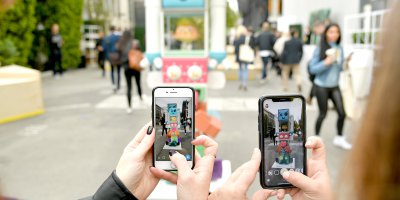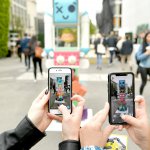
Augmented reality assisting shoppers in the store get more product information. Source: Shutterstock
Can retailers embrace AR for immersive (and contactless) store experiences?
- Retail experiences need to involve less physical contact in the current circumstances, and after
- AR could offer a solution for immersive, contactless retail experiences
In a very saturated but restricted market, retailers are facing challenges to sustain their operations like no other.
With quarantine and lockdown orders showing no signs of being ceased, most retailers have been forced to transform their operations.
For now, to meet increased demands and expectations, many physical retailers are shifting their businesses online, experimenting with e-commerce business applications and gaining a better understanding of the market.
However, understandably, not all retailers are able to make the shift. Some are choosing to pool resources and prepare for a “reboot” once consumers are allowed to go out and about again.
But even then, consumers will be highly alert and particularly conscious about how they interact with products in bricks-and-mortar stores – here’s where augmented reality (AR) technology can come in.
Why augmented reality?
Previously, AR was seen as a novel addition to in-store retail experiences as consumers get to explore products and services in an interactive way.
Real-life objects receive a digital boost in a virtual environment allowing consumers to gain more information about the products and use them without actually coming into contact with the product.
Such functions will be particularly key now and all throughout a post-pandemic world. Based on McKinsey, current limitations provide chances for retailers to connect emotionally to consumers and appeal to their shopping senses.
Some ways of doing so is by prioritizing consumers’ safety, establishing trust and offering convenience and ease of use. AR can definitely help retailers achieve all that as it takes away possibilities of physical contact between consumers and products or consumers and retailers while at the same time, retaining core retail experiences that fuel purchasing decisions.
Many retailers have already leveraged AR capabilities way before the outbreak, which enables them to now focus on scaling-up its application across the retail function.
Learning from these future-forward retailers could help, so here are some ways AR can be deployed:
#1 | In-store navigation
AR technology plays a big part in revolutionizing brick-and-mortar stores to make them ‘smarter’.
Empowering consumers with all the necessary information to help them understand the features of the store and allowing them to engage with the premise optimally should be the goals of future-forward retailers.
One way is by launching AR navigation features to help customers get to the store quickly and safely.
Retailers can choose to provide consumers with directions to the stores from different mall entrances or with in-door maps to enable them to find items quickly in the store – or both if necessary.
Launching such capabilities will let consumers know that their safety is valued and by getting them to their destination quickly without risking too much contact with other visitors.
# 2 | Interactive product catalog
Looking at catalogs can be visually draining sometimes as it doesn’t stimulate consumers’ imagination. This is particularly important for retailers of furniture and home appliances.
These products can really consume shopping time as consumers would have to take measurements of spaces or areas at home to see if the furniture they like would fit well.
AR can help consumers make better decisions and allow them to feel empowered when browsing catalogs by projecting selected products in the areas and corners that they want – meaning they can simply browse from home.
IKEA has launched this capability about six years ago, highlighting the fact that they understand that buying furniture is a long-term investment and consumers want to make sure they make the right choice.
Such a concept can also be adopted by retailers in the automobile and real estate industry.
# 3 | Brand marketing and advertising
Other than augmenting the retail experience and customer experience for consumers, retailers have to also focus on fostering brand loyalty. AR-powered marketing and advertising is definitely an effective way to reach to consumers in an interactive way.
The technology can be used to create immersive experiences for consumers from just a scan of a product logo. AR-based marketing can help create personalized advertising that actually allows consumers to control the virtual environment they are in and the kind of experiences they want to immerse in.
These retailers will also be focusing on in-store technology advances to help shape more digital, seamless, interactive and future-forward retail experiences.
This will then boost the retail tech investment sector which is already growing rapidly as spending reached over US$3 billion last year alone.
One thing for sure, retailers that leverage AR in their quest to overcome the challenges that the pandemic has brought will have higher chances of coming out on the other side of this business climate.
READ MORE
- Ethical AI: The renewed importance of safeguarding data and customer privacy in Generative AI applications
- How Japan balances AI-driven opportunities with cybersecurity needs
- Deploying SASE: Benchmarking your approach
- Insurance everywhere all at once: the digital transformation of the APAC insurance industry
- Google parent Alphabet eyes HubSpot: A potential acquisition shaping the future of CRM


